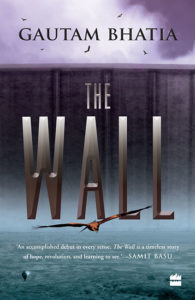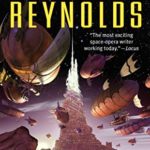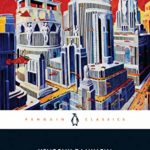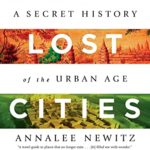To round out for now this series on cities in SFF, I’m revisiting a few novels that capture the importance of how people experience urban environments and how the massive structures affect their language and thought. A city, after all, is not just buildings and a way of physically organizing dense populations, but also a culture and mindset that influence how people think about what is possible in their lives. The physical structures say a lot about how power is distributed and also about what is culturally most important. There was a big change in urban cultures, for example, when office buildings supplanted religious buildings as the biggest and most awe-inspiring structures and a corresponding change in how people conceived their futures.
Culture determines a lot about how people are raised, what they learn is important and, in fiction usually, what they have to overcome. The city becomes the physical expression of cultural barriers as well as possibilities. Here are three very different examples of the impact of cities in SFF on peoples’ minds and lives: the imperial capital city/planet of Teixcalaan (A Memory Called Empire), the circular city of Sumer (The Wall), and the border city of a future Tel Aviv (Central Station).
Teixcalaan
In Arkady Martine’s A Memory Called Empire and A Desolation Called Peace, we get a strong contrast between the remote mining station of Lsel (a toroid with thirty thousand people) and the splendor of the imperial capital Teixcalaan. We first see the planet-wide city through the eyes of Mahit Dzmare, Lsel’s ambassador to the empire, who is awed by its appearance as she approaches from space. It was “haloed in white fire and shone like a glittering sea, an entire planet rendered into an ecumenopolis, palatially urban.” (A Memory Called Empire, Kindle edition, location 126) The voice of her predecessor, implanted in her brain, immediately undercuts this vision by reminding her that’s the way she’s meant to think about it.
For Teixcalaan is a city ruled by an emperor in which almost every citizen has a cloud-hook attached to their eyes, and that device immerses them in a stream of data that tells them where to be and what to do. Power is experienced in images and language. At one point, Mahit’s guide offers to describe the city to her by reciting poetry. The jewel of the world is captured as “a collapse between narrative and perception” (AMCE, location 275).
Clothing presents images of rank, names convey fine distinctions of authority, and mastery of poetry is essential. At one point, it is a poem that stirs massive unrest. And the ailing emperor tries to secure his succession through a carefully stage-managed and gruesome tableau for public display. The city and its imperial culture prescribe the roles of people’s lives, and much of the drama comes from attempts to manipulate and reposition anyone who might interfere with the complex decorum of the exercise of power. The imperial power and the city that embodies it are described as a “crushing onslaught of symbolism” (AMCE, location 6430).
Sumer
The city of Sumer (featured in Gautam Bhatia’s The Wall and The Horizon) reflects in its structure, at least according to myth upheld by a powerful religious order, a perfect circle, like the circle of time. The mysterious race of Builders, the myth says, fought a timeless war between order and chaos. They determined that the people were not ready for the open world and so surrounded the city with a massive wall that limits not just their view of the world but also their language and imagination. Within Sumer, people live in semi-circular areas that define their rank and wealth. Right in the middle are four great towers housing the institutions of power and religion meant to awe and keep in their places the people of the city.
But these novels tell a story of rebellion built on a deep longing to break through the barrier of the Wall and find a fuller reality in the open. And that would lead to a new language as well. Poetry and song are important in this story, but they arise not just from the ruling classes but from voices of discontent among the people. By breaking the Wall and the circle of time, the artificial language of this limited world can open to the full reality. Words within Sumer, the young rebels known as Tarafians say, are a pale reflection of things as they are, but beyond the Wall, words are alive and capture the fullness of unbounded life.
Though ruled by a political and religious elite that try to enforce the myth of perfect order reflected in the structure of the city, Sumer has its history of rebellion. The present order was based on a set of promises that people would share in wealth and authority, yet those promises have been broken. So authority has a kind of constitutional basis, even though its elite tries to cloak this in a mythic idea of order, and discontent among the people becomes a powerful force for change. Mithila, in spite of her wishes becomes leader of the young Tarafians and of a revolution that tries to break open the Wall to allow the people to live within the full scope of reality.
Central Station
Lavie Tidhar’s Central Station describes a huge spaceport located in the area between Arab and Jewish parts of the city. As such it is a gathering place of people from other worlds and of those who don’t fit in. We learn about this city through the personal relationships of its characters as well as their memories and links to the past. One character established a method for transmitting his families memories down through the generations. So the one we meet in the present day of the story, Boris Chong, bears all those memories while adding his own experience.
Most people in this city are “noded” or connected to the Conversation that continually brings them the chatter of the world. But in this city, the emphasis is not on overall control by the powerful but on the decisions of individuals and the influence of family histories.
There is a group of robotic soldiers, once the mainstay of armies, who have outlived their usefulness and eke out a rusty existence looking for spare parts and repairs. Religious cults have formed around relatively recent figures, yet there is no controlling religious hierarchy. The emphasis is on the mixing of disparate people and their efforts to survive. A Strigoi, or a kind of vampire who feeds on people’s data streams, arrives and becomes an outcast while also rekindling her old relationship with Boris. An un-noded man, a bookseller with a fascination for old pulp novels, falls in love with the Strigoi and is safe from her because he is not connected to the world of data. A woman who captains a spaceship in virtual reality falls in love with one of the robot soldiers.
There is a constant mixing of lives of people who are very different beings, and that gets at the essence of this liminal city. The great spaceport of Central Station is the fitting symbol of this world, as it brings together travelers from all over the solar system as well as people who live in its neighborhoods permanently and who come from such disparate backgrounds. Central Station presents a hopeful future of a Tel Aviv where human intimacy tries to overcome drastic differences.





Leave a Reply